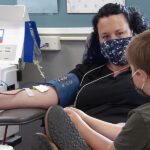In Salt Lake City, a city known for its spirit of service and community support, donating plasma has become an essential way to make a meaningful difference. Plasma donation is more than an act of kindness; it is a crucial lifeline for thousands of patients suffering from serious health conditions. For residents looking to give back while also receiving a modest financial reward, donating plasma in Salt Lake City offers a unique and impactful opportunity.
What is Plasma and Why is It So Important?
Plasma is the straw-colored, liquid component of blood that carries cells and proteins throughout the body. It makes up about 55% of blood’s overall content and is rich in crucial proteins such as albumin, immunoglobulins, and clotting factors. These proteins are essential for maintaining blood pressure, defending against infections, and ensuring proper clotting.
Plasma-derived therapies are irreplaceable treatments for individuals living with immune deficiencies, bleeding disorders like hemophilia, and severe burns. Because plasma cannot be synthetically created in a laboratory, donations are the sole source for manufacturing these life-saving treatments. This reality makes every contribution of plasma invaluable.
The Process of Donating Plasma
Donating plasma in Salt Lake City is a straightforward but highly regulated process designed to ensure safety for both the donor and the future recipients of the plasma.
When donors arrive at a plasma donation center, they first go through a screening process. This includes a review of their medical history, a quick physical examination, and vital signs checks like blood pressure and pulse. Once cleared, the donor undergoes a procedure called plasmapheresis. Blood is drawn from the donor, plasma is separated out using specialized equipment, and the remaining blood components — such as red blood cells and platelets — are returned to the donor’s body.
The entire process usually takes about 90 minutes for return visits, though the first visit may take closer to two hours because of the initial screening. While it requires a time commitment, many donors quickly develop a routine, seeing it as a regular way to contribute to the health and well-being of others.
Who Can Donate Plasma?
Not everyone is eligible to donate plasma, and centers in Salt Lake City adhere closely to FDA and local health regulations. Generally, plasma donors must meet these criteria:
- Be between 18 and 65 years old
- Weigh at least 110 pounds
- Be in good general health
- Provide valid identification and proof of address
- Pass a basic health screening on the day of donation
Certain factors, such as recent tattoos or piercings, travel history to certain countries, or specific medical conditions, may temporarily or permanently disqualify an individual from donating. Each center carefully evaluates donors to protect both parties involved.
What to Expect When Choosing a Plasma Donation Center
Selecting a plasma donation center in Salt Lake City often comes down to convenience, comfort, and trust. Most centers follow strict federal guidelines to ensure donor safety and high-quality plasma collection. When deciding where to donate, it’s helpful to consider factors such as location, cleanliness, staff professionalism, and how organized the donation process feels.
A good plasma center should have welcoming staff who clearly explain each step, maintain a hygienic environment, and offer thorough health screenings. Many facilities encourage making appointments ahead of time to minimize waiting times, though walk-in donations are usually available.
Donors can also look for centers that offer streamlined online scheduling, flexible donation hours, and comfortable waiting areas to make the experience as smooth as possible. Whether you are donating for the first time or returning for regular visits, finding a center that prioritizes both your well-being and the needs of patients makes the entire process more rewarding.
Compensation for Donating Plasma
While the altruistic benefits of plasma donation are significant, many donors appreciate the financial incentives that accompany their contributions. New donors in Salt Lake City can earn several hundred dollars in their first month of donating. Some centers advertise bonuses that can exceed $700 for first-time donors who meet promotional criteria.
Ongoing donors also receive consistent payments for their time. Most centers pay between $30 to $50 per donation, depending on factors like the volume of plasma collected and the frequency of donations. Since FDA regulations allow plasma donation up to twice a week (with at least 48 hours between donations), donors can realistically supplement their income while supporting life-saving therapies.
Preparing for a Successful Donation
Proper preparation can significantly improve the donation experience and recovery afterward. Donors are encouraged to drink plenty of water the day before and the day of their appointment. Staying well-hydrated helps the plasma flow more easily and reduces the risk of dizziness or fatigue afterward.
A nutritious meal, rich in protein and iron, eaten a few hours before donating can also help maintain energy levels. Foods like lean meats, leafy greens, and beans are particularly beneficial. Avoiding alcohol and caffeine before donating is equally important, as these substances can dehydrate the body.
Finally, donors should come prepared with valid identification and plan to stay at the center for around two hours, especially on their first visit. Bringing a book or headphones can make the time pass more quickly.
The Broader Impact of Plasma Donation
Donating plasma in Salt Lake City extends benefits far beyond the walls of the donation center. Each donation has the potential to improve — or even save — multiple lives. Plasma-derived therapies are used not only for patients with chronic diseases but also for trauma victims, surgical patients, and individuals undergoing chemotherapy.
In a way, plasma donors become silent heroes, making it possible for countless individuals to lead longer, healthier lives. They form a critical part of the healthcare system, ensuring a steady supply of plasma for both emergency treatments and ongoing care needs.
Debunking Common Misconceptions
Some prospective donors hesitate because of common myths surrounding plasma donation. For instance, many believe donating plasma is painful. In reality, most donors describe only a mild initial pinch from the needle insertion, followed by little to no discomfort during the actual donation.
Others worry that donating plasma weakens the immune system. However, plasma regenerates quickly within the body — usually within 24 to 48 hours — and donating under medically supervised conditions is completely safe for healthy individuals.
Understanding these realities can ease apprehensions and encourage more people to participate in this life-affirming act.
Conclusion
Donating plasma in Salt Lake City is an extraordinary way for individuals to serve their community, earn some financial compensation, and contribute to global healthcare solutions. With multiple highly rated donation centers and a city culture rooted in compassion and volunteerism, Salt Lake City offers an ideal environment for plasma donation.
Whether motivated by altruism, the opportunity for extra income, or a desire to support cutting-edge medical treatments, donors play an essential role in saving lives. The next time you consider how to give back, remember that donating plasma might be one of the most powerful actions you can take — right here in your own backyard.











